If you want to know about the roman architecture or Indus valley civilization or components of Hindu temple, please click the link.
The Vedic Civilization, also known as the Vedic culture or the Vedic period, was a complex and diverse civilization that emerged in ancient India around 1500-1000 BCE. It was characterized by the practice of Vedic religion and the composition of the Vedas, a collection of sacred texts that form the foundation of Hinduism.
- There is much speculation of when exactly did the Vedic culture flourish. John Marshall, who first studied the same, mentioned that it would be before 1500 or 1000 BC. But the latest scientific research pins the Vedic culture to be predate the Indus valley civilization. The suggested time is near 9000 BC.
- The Vedic Cilivization was of an agri – pasotoral community living in smaller villages. They had been living in close harmony with nature. Many rishis and sages over generations lived isolated lives in forests keenly observing life, the human body and the human mind.
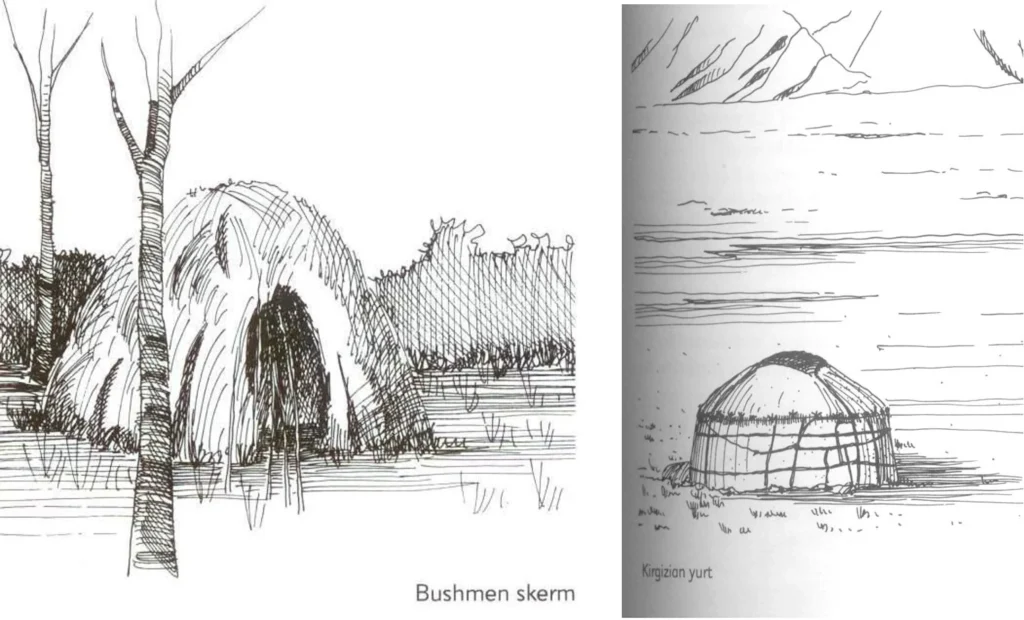
- Their concern was not individual well-being or the well-being of their village or clan, but a global harmony. They had an overview of life and understood the interconnectedness of all life – animate and inanimate.
- Much in awe of the spectacles of natural phenomenon, they sung praises of their Gods – Agni, Varun, Indra, Prithvi and Aakash. Their traditions were oral, and knowledge was passed down generations by rote learning and reciting hymns. Stress was laid on right pronunciation and it was considered meaningless if the pronunciations were imperfect. To ensure that, two priests would recite the verses together so that they self-corrected themselves by listening.
- They communicated with the spirit world and their gods thru fire. Matter was offered to the sacrificial fire in the form of butter, grain, soma etc., and the fire purified it and converted it into its non-manifest form fit for the consumption of their gods.
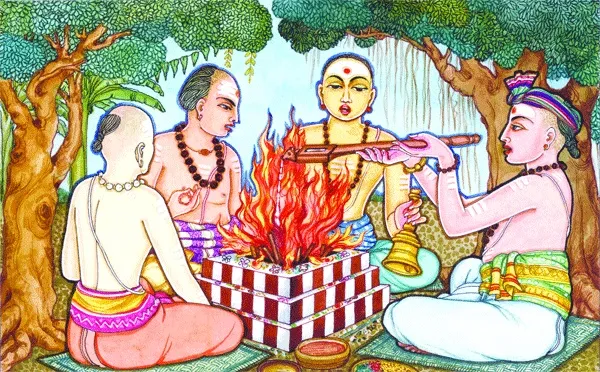
- Astronomy was highly developed to align their worship and sacrifices with the exact positions of planets. Mathematics was developed to build exact alters for worship. Trignometry, geometry, arithmetic were well known.
- Society was divided into the four varnas: the brahmans – who were the center of all knowledge, the kshatriyas – who were the controllers of political power, the Vaishyas- who were tradesmen and farmers and the Shudras – who were the artisans and the craftsmen. it was the duty of the Khatriya to protect the Bhrahman and the Vaishya communities while the Shudras, rich in tools and physical strength protected themselves.
- Dhyan, yoga and medicine was developed. There is mention off cataract surgeries, plastic surgeries, operations etc. Previously liquor was used as anesthesia, later when opium was introduced thru the arabs, opium was used as anesthesia.
- Life expectancy was 100 years and it had been subdivided into the four ‘ashrams’ – the student years of celibacy and learning, the family years of procreation and earning, the next 25 years were dedicated to the community and works of charity while the last 25 years were for God and renunciation from active community life.
- It is now believed that this civilization may have been the cradle of the world. Knowledge passed on from here into mesopotamia and egypt and onwards into europe.
- Their houses were built of earth and timber, so they do not survive the centuries. Burnt brick had not yet been evolved. No temples of that period have been found. Seals in the later Indus valley civilization carry impressions of a seated god similar to ‘Pashupati’ – the protector of the animals. The cow was revered and milk & milk products, wheat &, barley, fruits and vegetables were their staple diet.

- The surrounding forests provided ample building material in the form of bamboo and mud. The Aryan hut in its most basic shape was circular in plan with a thatched roof over a network of bamboo ribs. This was later elongated into a rectangular plan with a barrel shaped thatched roof. Cluster of these huts formed a courtyard. To maintain the barrel, form a thong or string, perhaps an animal hide was stretched across the ends of the bamboo
- The cities of the later Indus valley civilization were laid out in accordance with the tenets of the Vedic rule. The river flowed to the east of the settlements so they could watch the rising sun over water. Streets were north south, and most houses were entered from the east. The Indus valley civilization is now considered an extension of the Vedic villages.
- By studying the astronomical positions mentioned in the Vedic texts, and the mention of constellations moving about in circles in the sky, it is speculated that they began life in the arctic circle, in a time when it was not covered over in ice as now.
1) Evolution of the Vedas
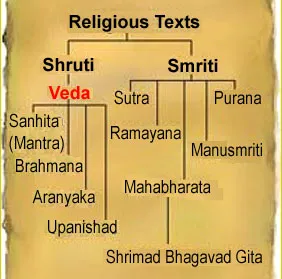
- The Vedas are referred to as the shruti. The Vedas are the oldest extant Hindu texts. The ideas expressed in the Vedas were traditionally handed down orally from father to son and from teacher to disciple. Therefore, these ideas had been in circulation for a long time before their codification and compilation, which are attributed to a rishi named veda vyasa (literally, “the splitter of the Vedas,”).
- India is country which passes huge ancient knowledge in the form of Vedas. “Vedas” means knowledge. They describes the study of basic meaning, type and form of our ancient knowledge and wisdom.
There are four Vedas in ancient wisdom
- Rigvedam – the Veda of verses, is a collection of poems, hymns and invocations of deities, reflecting myths, rites, battles and insights of many kinds. Texts and procedures for rituals and rites of brahmanans are generally derived from it.
- Yajurvedam – the veda of chants consists of verse (poetry) and prose (writing style) largely concerned with rituals.
- Saamavedam – the Veda of sacrificial formulas on the other hand, consists mostly of parts of Rigvedam set to music, and a few (less than 100) stanzas of its own. But the tune of rendering (chanting) Saamavedam is totally different from that of Rigvedam and Yajurvedam, and is melodious.
- Athharwavedam – the Veda of Atharva priests, is somewhat similar to Rigvedam, but with stress on the practical aspects, and is probably addressed to a different stratum of society.
3) Evolution of Vedic houses
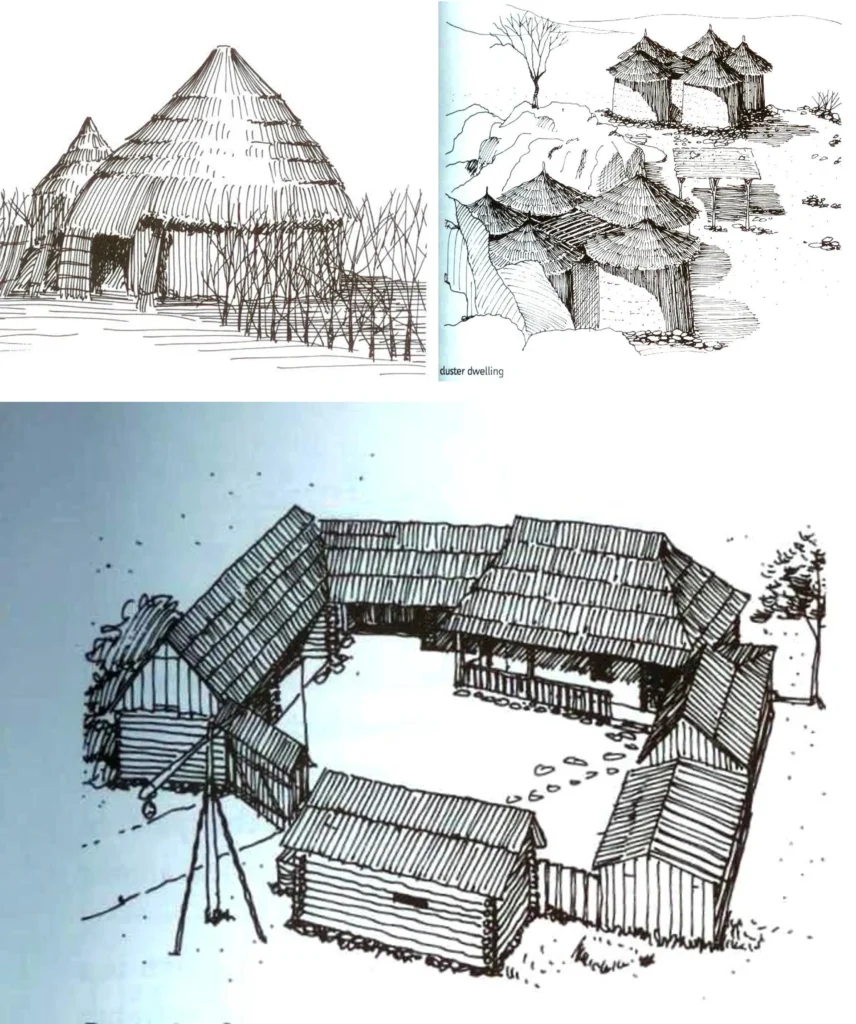
- Circular individual huts were built in clusters around a central court.
- These circular huts evolved into rectangular huts
- These later evolved into the later courtyard houses.
4) The stages of Vedic houses

- Later, with trade the burnt brick may have been introduced. Mohenjo daro is built on a high brick platform because of the periodic flooding of the indus river.
- The aryans were not a barbaric tribe that slaved the indus civilization and moved eastward into india. Rather, it is now believed that the river saraswati dried up, because of perhaps due to an earthquake, and with it the cities were abandoned for want of water and hence food. Most of the people moved into assyria and some crossed over into the indo-gangetic pains in around 1500bc to 1000bc.
In that time the small states evolved. There were: Gandhar, Kanboj, Kuru, Panchala, Kosala, Videha, Magadh, Kashi, Anga, Kikata, Banas, Vidarbha etc.
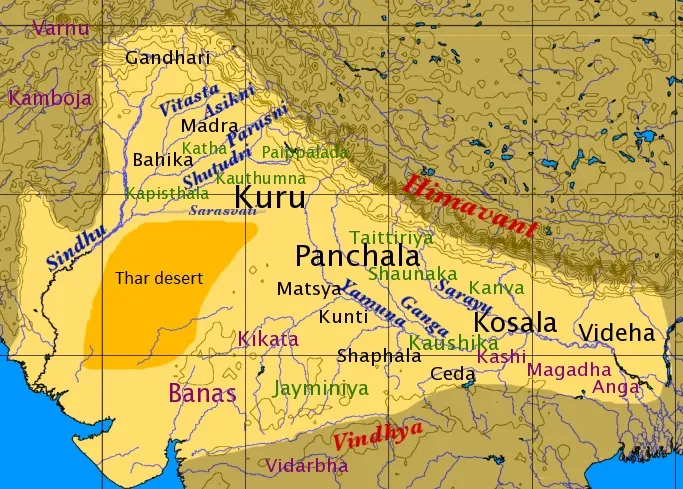
- These, though connected by bloodlines and marriage were often at war with each other
It was during this time that the Veds were finally written down and their knowledge preserved. The Upnishads, the Gita and the brahmanas were written.

- By now they were familiar with horses and the ‘ashwamegh’ yagnas were conducted. Horses were also used in battle.
- The priests helped the common man in conducting the prayer rituals. People prayed for abundance of sons, cattle and wealth.
- The great epics, the Mahabharata and the Ramayana are from during this time.
- The transition from the early Vedic age to the later Vedic age was marked with the emergence of agriculture as the dominant economic activity with a significant decline in cattle rearing.
- Initially governed by elected leaders counselled by sabhas and samities, slowly the participation of people in governance decreased. Lavish ceremonies were performed for the coronation of kings with the purohit and the senani in attendance with all pomp and glory.
4) City-states and timber construction
- With the conversion of the early Vedic people into agriculturalists, A growing rivalry for precious fertile land was inevitable.
- Groups of small villages banded together, and small ‘cities’ began to take shape.
- A palisade wall inevitably protected these and the buildings within were also made almost entirely of wood.
- The vedic carpenters developed skill in timber construction of a very high standard
- It is not surprising, therefore, that in later ages timber construction techniques were employed even though the material of construction was radically different – i.e., stone.
- In general, the cities of the Vedic period were rectangular in plan and divided into four quarters by two main thoroughfares intersecting at right angles, each leading to a city gate. One of these quarters contained the citadel and another housed the residential area. A third quarter was reserved for the merchants, and the last for tradesmen who could display their wares.

- Making the outlines of the Vastu-Purushmandala and Division in to plots ( vastu-purushmandala )
- Layout of the principal streets.
- Division in to hypothetical rings of Brahma, Daivika, Manushya & Paisacha.
- Division in wards by means of branches roads, erection of outer wall, gates and the moat.
- Erection of various edifices according to site-planning and folk planning principles.
- Town planning in Ancient India is evident from various ancient texts and puranas. Various vastu shastra text like artha sastra of kautilya and Sukra Nitisara. These texts illuminate the development of civic art. According to these texts ancient tows are categorized on the basis of size, shape and purpose.
- According to size
- Rajdhani – The capital of the king.
- Sakhanagra – All other categories of town besides Pura.
- Karvata – Smaller Town
- Nigma – Smaller then Karvata
- Grama – Smaller than Nigma
5) Various aspects in Vedic civilization
The caste system
- There are lots of ancient texts related to different fields right from language, grammar, drama, play, poetry, art and various branches of science, physics, chemistry, medical, engineering, vaastu, geology etc.
- Cosmic: Related with creation of universe, heavenly bodies, sun, moon, stars, constellation etc. It is also termed as astronomy.
- Astrology – Effect of cosmic bodies on human
- Geology – It deals with character of soil.
- Geography – It deals with basic physical structures of earth like hills, rivers.
- Sociology – It deals with social aspects of society.
- Society was divided into the four varnas –
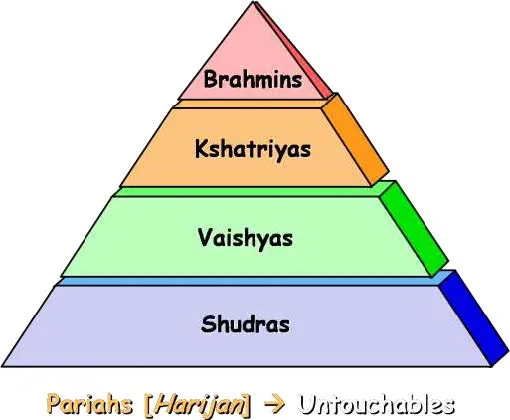
- the brahmans – who were the center of all knowledge,
- the kshatriyas – who were the controllers of political power,
- the vaishyas- who were tradesmen and farmers and
- the shudras – who were the artisans and the craftsmen.
- it was the duty of the Khatriya to protect the Bhrahman and the Vaishya communities while the Shudras, rich in tools and physical strength protected themselves.
- Dhyan, yoga and medicine was developed. There is mention off cataract surgeries, plastic surgeries, operations etc. Previously liquor was used as anesthesia, later when opium was introduced thru the Arabs, opium was used as anesthesia.
Power and administration aspects
- People around his area were more aggressive and had repeated invasions
- Political leadership was the focal point.
- Insecurity in life increased the importance of religion- belief and looking towards the divine for security.
Social aspects
- The invasion led to social stratification – conqueror and the defeated.
- The defeated as captives and slaves were put into agricultural works and clustered around religious centers.
- The conqueror were higher castes and not into agriculture
- One leader – political cum storage in charge – at some central location – surrounded by higher caste people engaged in defense in administration
- Another leader – Religious leader – another central location-surrounded by priests and people of higher castes.
Economic aspects
- Economy was principally agricultural
- Agriculture is space extensive
- Granary and storage were important – This space needed protection hence was located near the defense leader’s area at the centre.
Technological aspects
- Hardly any industrial activity
- Impact of straight and parallel lines were derived by the terracing of agricultural land and the dams which was the origin of the ziggurats.
- Transportation was on foot . Inter settlement transportation was on water.
- Level of water In the rivers change and hence special protection wall were needed.
- The river and the spine of transportation divided the settlement into two parts..
Town planning aspects
- The science of building was quite advanced during the Vedic period.
- The Vedic civilization leaving its primitive stage far behind had registered remarkable progress in the field of building edifices and planning villages and towns.
- The symbolism which abounds the architecture and town planning of Vedic town was the outcome of this quest of gyan
- The scope of Ancient Indian town planning included all relevant requirement of a healthy civic life. This science includes descriptions of temples, moats, city, forts etc.
6) Example
Kashi : one of the world’s oldest living City (from 1200 – 1000 BCE)
(Lebanon has the oldest from 5000 BCE, lower Egypt from 4000 BCE, Mycenaen Greece from 1400 BCE,)
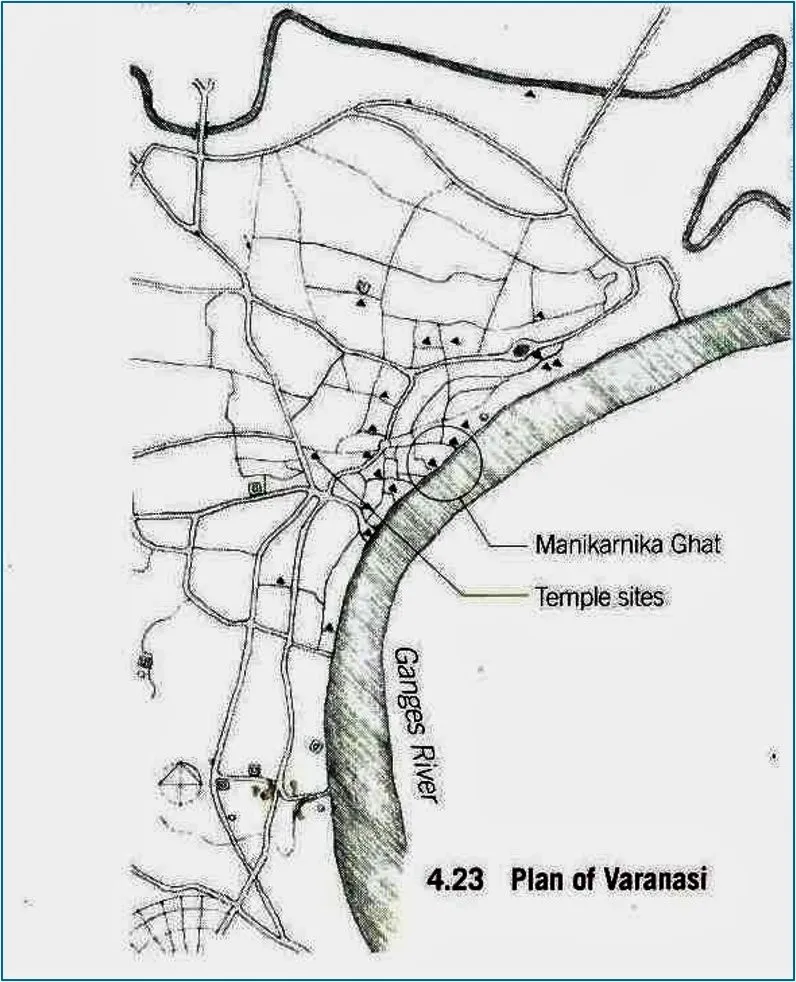
- The Ganges was at the center of Vedic mythology. At Varanasi, on the Ganges, even today vestiges of Vedic rituals continue. Varanasi was founded as the capital of the Kashi Mahajanapada but lost its political importance after being conquerred by kosala and then magadha around 600 BCE. It developed, however, into a leading religious site. When buddha gained enlightenment, his first stop was Varanasi. (Sarnath is a mere 16km away)
- At dawn every morning thousands of Hindus gather on all the steps leading down to the shore (ghats) to face the sun that rises across the broad expanse of the Ganges and that is reflected in the waters.
- The city is built on a natural berm, located on the northwestern banks of the Ganges at a point where the river makes a sharp right turn, flowing north and then west. The high berm (built up with karkar or lime concretion) not only ensures that the city enjoys a dramatic prospect, some 15 meters above the normal level of the water, it also ensures that the city is protected form the river’s floods, the impact of which is borne by the opposite shore.
- Because of its geography, Varanasi has been situated at the very same spot for 3000 yrs., unmoved by the Ganges, yet in constant engagement with its rising and falling waters. Behind the berm, in a semi-circular arch, lies the dense fabric of the medival city, with twisting narrow streets, temples, water tanks and street shrines.
- The ghats and the river have an engagement of ‘shiva and shakti’ – the Ganges being ‘shakti’.
- Benaras became the center for learning of Aryan religion and philosophy., Classical music and dance. The city also flourished as an industrial and economic center famous for its muslin and silk fabrics, ivory works, perfumery and sculptures.

- The vishweshwar temple is considered to be the pillar at the center of the world – or ‘axis mundi’
Philosophy

- The pattern of traditional and royal cities of India mostly duplicates a celestial archetype, reflecting cosmo-magical power.
- Pilgrims to the city take the five sacred routes (parirama) from the outer circle to the inner circle reaching to the highest at the inner sanctum. Each of the five journeys starts and ends at the Visveshwara shiva temple situated just off the ghats of benaras.
- This idea runs parrell to a shrinking world but expanding universe.
- It also shows parallels with shiva’s dance symbolizing cosmic cycles of creation and destruction and also the daily rhythm of life and death.
- “By condensing the cosmos into a small sphere, its laws can be observed and experienced very clearly, and human life can be placed more accurately in accord with them.” Rana B.P. Singh
7) Ancient town planning principles
If you want to know about the ancient town planning principles, please click the link.
The evolution of the Vedic Civilization had a profound impact on the development of Indian culture, religion, and society. It continues to shape and influence the beliefs, practices, and traditions of people in India and around the world today.